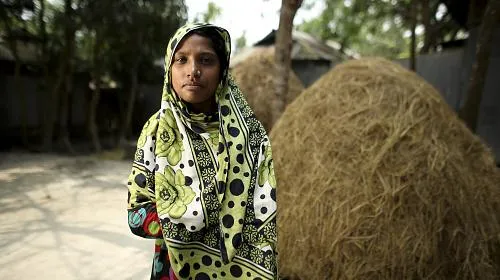“Vows of Poverty” report identifies countries where more girls marry before age 18 than enroll in secondary school; CARE calls for greater support of adolescent girls to mark International Day of the Girl.
BISHNUPUR, Bangladesh (Oct. 5, 2015) — Girls in an alarming 26 countries are more likely to be forced into marriage before age 18 than to enroll in secondary school, according to a report released today by the poverty-fighting organization CARE.
Titled “Vows of Poverty” and released to mark International Day of the Girl, the report provides a snapshot of the forces driving girls into marriage and out of school in the 26 countries while also describing what needs to happen to reverse those trends. “No girl should be more likely to walk down the aisle before age 18 than into a high school classroom,” said Michelle Nunn, president and CEO of CARE. “The fact that this is the norm in so many countries should be a wake-up call for all of us who care about adolescent girls and want to give them a chance to reach their full potential. Every time a girl is forced into a marriage or prevented from attending school, it’s a missed opportunity to improve that girl’s life and strike at the roots of poverty.”
Niger tops the list, with 76 percent of girls marrying before age 18 and only 10 percent enrolling in secondary school. Chad, Central African Republic, South Sudan and Somalia follow, each with at least a 40 percentage point gap between their rates of child marriage and of secondary school enrollment for girls. Many of the underlying causes of child marriage – including social norms that devalue women and girls – apply across all the countries. Other forces are localized, from the trafficking of girls in Mauritania to dowry considerations in Bangladesh to civil conflict in countries such as Afghanistan and Mali.
Worldwide, about 39,000 girls are forced to marry each day. That’s another child marriage every 2 seconds. Meanwhile, 62 million girls are not in school, and half of them are adolescents.
Secondary school enrollment is a critical marker because although many countries have closed or nearly closed their gender gaps in primary education, they still face significant gaps in secondary education. Secondary school typically coincides with the onset of adolescence, when girls become more vulnerable to a host of gender-related risks, from domestic work and sexual coercion to violence, pregnancy and marriage.
Jobeda Begum, now 21, was a top student in northern Bangladesh before being forced into marriage at age 15 and, shortly after, yanked out of school to help with household chores. “I wanted to study to 12th grade,” said Jobeda, whose story is featured in the report. “. . . It’s a dream long gone.”
“Vows of Poverty” also highlights some of the promising solutions to child marriage that are taking hold from Bangladesh and Nepal to Ethiopia and Malawi. In the report, CARE asks people to mark International Day of the Girl by signing a letter to U.S. First Lady Michelle Obama thanking her for promoting an end to child marriage through the Let Girls Learn initiative and urging her to support a strong inter-agency adolescent girl strategy. Such a strategy is essential to assuring that the U.S. does its part in putting the world on track to meet the U.N. Sustainable Development Goals (SDGs), enacted last month in an effort to end global poverty and close equality gaps by 2030. The goals call for an end to child marriage by 2030 and for all girls to complete secondary school.
About CARE
Founded in 1945 with the creation of the CARE Package®, CARE is a leading humanitarian organization fighting global poverty. CARE places special focus on working alongside poor girls and women because, equipped with the proper resources, they have the power to lift whole families and entire communities out of poverty. Last year CARE worked in 90 countries and reached more than 72 million people around the world. To learn more, visit www.care.org. The report: Is available for download at www.care.org/vowsofpoverty or through media contacts below.
Media Contacts
CARE has child marriage and girls’ education experts available for interviews around the world, including many of the countries detailed in “Vows of Poverty.” Contact Nicole Harris at nharris@care.org , +1 404-735-0871; or Brian Feagans at bfeagans@care.org, +1 404-979-9453.

